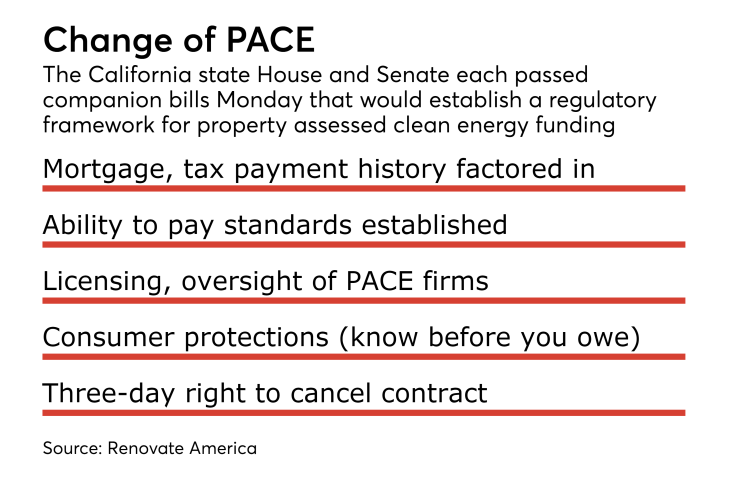It's not often that securitization industry participants welcome increased regulatory oversight.
But Property Assessed Clean Energy programs have proven so controversial that providers see a benefit to strengthening and standardizing underwriting standards.
So panelists at ABS East had only good things to say about the two bills approved by California lawmakers that would create a comprehensive consumer protection, underwriting and regulatory framework for PACE.

Cisco DeVries, the chief executive of Renew Financial, said the bills will bring much-needed stability to the PACE, which adds an assessment on property tax bills, to pay for energy retrofits to homes and businesses, the legislation could also stand as a model for eventual national expansion of the residential and commercial energy retrofit program, he said.
“It’s a historic moment for PACE,” the CEO said. “There’s been a need for a stable, long-term consumer regulatory regime that dealt with PACE as a unique product; that it was just not that same as a mortgage or consumer loan.”
The legislation would require lenders to underwrite to a borrower’s home equity, mortgage and tax payment history, plus follow ability-to-pay and reporting/disclosure requirements. Consumers will have a three-day right-of-rescission and cancellation on projects.
The California State Assembly bill was passed unanimously, and the upper-chamber state senate bill saw only two no votes. (The legislation was pending as of late September, awaiting Gov. Jerry Brown’s signature).
The legislation was backed by an unusual consortium that include not only PACE lenders but bankers and realtors, two groups that have fought against PACE expansion in California. Bankers take exception to the fact that PACE liens have a senior claim on a property to a mortgage. Realtors argue that they can make it more difficult for homeowners to sell or refinance.
Stacey Lawson, executive vice chairman of Ygrene, said at the same panel that many of the requirements in the California legislation were already being followed — and were even developed — by the industry to improve underwriting even with a very low delinquency rate.
“The issuers and all of the other stakeholders have been very involved in helping to advance the substantive regulation and rules to help support PACE,” said Lawson, “not only from a consumer protection standpoint but also from the perception from investors and others in the industry as a very responsible and thoughtful set of folks that are advancing this asset class.”
The companion bills would create a comprehensive consumer protection, underwriting and regulatory framework for PACE.
More than 150,000 Californians have used PACE to make energy and efficiency improvements to their properties and pay for them over time via an additional line item on their property taxes, according to Renovate America.
In addition to California, PACE programs have also been launched in Florida, Georgia and Missouri.
“I think what we’re seeing is a maturing industry that’s looking to [build] from a $1 to $2 billion industry in a few states,” said DeVries, to one with “a larger national scale with this [legislation] as a very powerful model.”





